
A yen for serious coin shrinking
Tesladownunder, Sun Jun 04 2006, 06:55AMI haven't used my big capacitor bank for coinshrinking yet. (215uF 12kV, 16kJ) I have tried with smaller setups using 1.5kJ but with only a few percent shrinkage of an aluminium disc. This has been documented on my site and in 4HV. Other related coinshrinking topics include the definitive site from Bert Hickman and Steve Ward's MO cap shrinker from the old forum.
A few months back I was rifling though the physics prof's loose overseas change and found 8 Japanese yen. These are small light aluminium like coins.
So now I had some yen for serious coinshrinking. Get it? Sorry....
Now first the setup.
Normal coinshrinkers use a coil and some dowel but no external support.
I wanted more of the force to be directed to the coin and to keep the work coil in proximity longer
The work coil was still left over from last years experiments and is 10 turns of 2mm wire. The key is that it was interoven with fibreglass cloth as the axial forces will slam the coil turns together and short them out. Plastic would get squashed but I was hoping the fibeglass might do better.
The whole thing was then wrapped in cloth from some garish print dress (not mine). It was then placed in a PVC endcap and short pipe, filled with water and frozen. That in turn went in another layer of endcap and pipe with the gap filled with water and frozen. The hope was that the cloth would add strength to the ice like glass fibre does to epoxy to give fibreglass.
I was all enclosed in a wooden box. I hid behind a blast shield and also had the setup monitoring current on the CRO with a Rogowski coil.
So here are the setup pics and the damage done following a 5kJ discharge.
The ice was shattered as were all the PVC components and a panel was broken off the box. It wasn't that loud using hearing protection and much less than an exploding wire.
Pics of results on the next post.
Peter
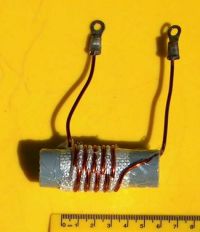
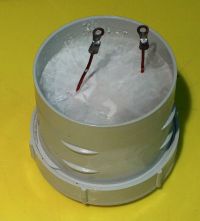

Re: A yen for serious coin shrinking
ragnar, Sun Jun 04 2006, 07:01AM
So where do you get your yen anyway?
:P
ragnar, Sun Jun 04 2006, 07:01AM
So where do you get your yen anyway?
:P
Re: A yen for serious coin shrinking
Steve Ward, Sun Jun 04 2006, 07:41AM
Something ive wondered about but never just tested for myself... ice isnt conductive (electrically)?
I would think 5kJ could turn a little aluminum coin into a small ball at 5kJ... considering what ive done to quarters and half-dollars.
Looks like you need some better containment .
.
Steve Ward, Sun Jun 04 2006, 07:41AM
Something ive wondered about but never just tested for myself... ice isnt conductive (electrically)?
I would think 5kJ could turn a little aluminum coin into a small ball at 5kJ... considering what ive done to quarters and half-dollars.
Looks like you need some better containment
 .
.Re: A yen for serious coin shrinking
Tesladownunder, Sun Jun 04 2006, 08:57AM
A small ball is right. The coin was a little unsupported on one side so I expected a bit of a lopsided result.
It is interesting trying to see the corresponding detail. Particularly the number 1 which looks like it is fracturing out.
Peter

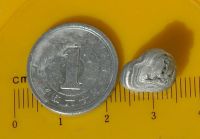
Tesladownunder, Sun Jun 04 2006, 08:57AM
A small ball is right. The coin was a little unsupported on one side so I expected a bit of a lopsided result.
It is interesting trying to see the corresponding detail. Particularly the number 1 which looks like it is fracturing out.
Peter


Re: A yen for serious coin shrinking
Madgyver, Sun Jun 04 2006, 09:53AM
Nice. I always figurred, that they could be great in Disc shooters, as they are realy light.
Madgyver, Sun Jun 04 2006, 09:53AM
Nice. I always figurred, that they could be great in Disc shooters, as they are realy light.
Re: A yen for serious coin shrinking
Tesladownunder, Sun Jun 04 2006, 11:19AM
Here are the copper fragments. Interesting how one part of the coil is almost unscathed apart from doubling its diameter where the other half is fractured, compressed and in pieces.
The current reading is interesting (first picture) and my Rogowski coil indicates a heavily damped waveform with a peak of 'only' about 50 kA. (50kA/div, 50uS/div) I had expected more. There are no discontinuities to fit with the wire disintegrating.
The second picture is a test run at only a few joules prior to the main shot (?2A/div, 50uS) shows the waveform of the same combo but with much more prolonged ringing so at full power the energy is being dissipated much faster although it difficult to be sure since the amplitude on screen is so much different.
Peter
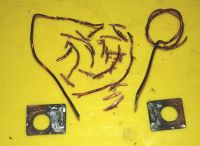

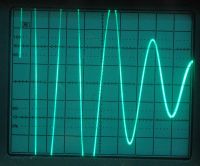
Tesladownunder, Sun Jun 04 2006, 11:19AM
Here are the copper fragments. Interesting how one part of the coil is almost unscathed apart from doubling its diameter where the other half is fractured, compressed and in pieces.
The current reading is interesting (first picture) and my Rogowski coil indicates a heavily damped waveform with a peak of 'only' about 50 kA. (50kA/div, 50uS/div) I had expected more. There are no discontinuities to fit with the wire disintegrating.
The second picture is a test run at only a few joules prior to the main shot (?2A/div, 50uS) shows the waveform of the same combo but with much more prolonged ringing so at full power the energy is being dissipated much faster although it difficult to be sure since the amplitude on screen is so much different.
Peter



Re: A yen for serious coin shrinking
Quantum Singularity, Tue Jun 06 2006, 04:12PM
I was wondering if any of you shrinkers have tried fiber reinforced packaging tape? I think several layers of that would be similar to fiber reinforced laminate and probably alot easier to use and cheaper? I am actually in the process of constructing a quarter shrinker and with the couple hours every other week I have available to work on projects, will probably take another couple months. I have most all the parts, just need to assemble.
Quantum Singularity, Tue Jun 06 2006, 04:12PM
I was wondering if any of you shrinkers have tried fiber reinforced packaging tape? I think several layers of that would be similar to fiber reinforced laminate and probably alot easier to use and cheaper? I am actually in the process of constructing a quarter shrinker and with the couple hours every other week I have available to work on projects, will probably take another couple months. I have most all the parts, just need to assemble.
Re: A yen for serious coin shrinking
Tesladownunder, Tue Jun 06 2006, 05:58PM
I am not sure that fibre reinforcing is the way to go yet and this was my only serious shot at coin shrinking. I have looked through Bert Hickmans gallery of coins and the energies at which they were fired. It seems to be efficient for 5kJ.
I have asked Bert for his opinion.
I expect the ice around it is more important but the coil expanded to twice its diameter anyway. The fibreglass was shredded anyway
Next time I will use my box girder section as combination blast shield and restraint for the ice. Getting harder to fit it into the freezer though..
Peter
Tesladownunder, Tue Jun 06 2006, 05:58PM
I am not sure that fibre reinforcing is the way to go yet and this was my only serious shot at coin shrinking. I have looked through Bert Hickmans gallery of coins and the energies at which they were fired. It seems to be efficient for 5kJ.
I have asked Bert for his opinion.
I expect the ice around it is more important but the coil expanded to twice its diameter anyway. The fibreglass was shredded anyway
Next time I will use my box girder section as combination blast shield and restraint for the ice. Getting harder to fit it into the freezer though..
Peter
Re: A yen for serious coin shrinking
Bert, Tue Jun 06 2006, 07:17PM
Something very strange occurred with this coin. The marked non symmetrical shrinkage was probably due to the coin being constrained only on one side. Since I normally strive for uniform shrinkage, I've never tried shrinking with only one dowel rod in place. Interesting effect!
I assume that 2mm wire is about the same as #12 AWG. From the work coil photo, the length of the coil looked to be ~3.2 cm, and the coil ID was perhaps about 2.5 cm. (BTW, I always use the coil ID, not wire center-to-center) to estimate the "effective" inductance, since proximity effect will bunch the current into a thin stripe along the side of the wire that faces the interior of the coil). The estimated open core (no coin) Wheeler inductance of your work coil was perhaps ~1.6 uH or so. The low power scope shot indicates that you got four complete cycles over a period of ~475 usec, for a resonant frequency of about 8.4 kHz. Assuming a 215 uF bank capacitance, your overall initial loop inductance (including "loaded" work coil, caps, switch, and bus bars) was about 1.67 uH - in the ballpark.
Assuming 5 kJ of bank energy (~6800 volts) and no change in work coil inductance, the predicted current peak would be about 77 kA. However, we know that the coil stretched and expanded as the current increased. In order for the measured current peak to only be ~50 kA, the "effective" work coil inductance must have increased to ~3.9 uH, implying that the work coil expanded to an average diameter of about 1.7" by the first current peak. Further, based on the shape of the intact portion of the coil, the portion that remained intact actually expanded to at least 2X the original diameter, while the portions nearest the coin expanded even more and fragmented. Fragmentation causes arcing that then bridges the gap between still-connected portions of the remaining coil. However, the coil was also simultaneously being axially compressed. This most likely led to some turn-to-turn shorting as well. Since most of the system energy (as you approach the first current peak) resides in the magnetic field surrounding turns of the work coil, any arcing between turns would not be directly reflected in your current waveform, other than showing up as markedly increased system losses.
Looking again at the high power waveform, there is still significant residual system inductance during the high power shot, since you don't see a sudden jump in resonant frequency (which might imply that the entire coil was bridged by an arc). The high power current waveform DOES show considerable increase in lossiness though, the hallmark of one or more arcs becoming the major lossy element in the system. Also, the decay envelope looks to be approximately linear - again a very strong indicator of arc(s) being the major lossy element(s) in the system. And, perhaps by encasing the coil in ice, you further "constricted" arcs that formed during the initial wire breaks, causing them to be more "resistive" than unconstrained arcs. In any event, I have little doubt that arcing is the source of your excess system losses.
Based on your results, it appears to me that your work coil began fragmenting on the way towards the first current peak, and that system energy was then lost at a very rapid rate through arcing. It might be possible to more easily detect when fragmentation begins by monitoring the voltage developed across the work coil. I'd recommend repeating the experiment, but this time using a simple close wound coil of heavy build polyamide-imide magnet wire, centering the coin with identical dowels on each side, and simultaneously monitoring coil voltage and current.
And obviously, you also need to develop a more robust containment method before repeating the experiment.... :^)
Good luck, and remember to wear your helmut and flak jacket...
Bert
Bert, Tue Jun 06 2006, 07:17PM
Something very strange occurred with this coin. The marked non symmetrical shrinkage was probably due to the coin being constrained only on one side. Since I normally strive for uniform shrinkage, I've never tried shrinking with only one dowel rod in place. Interesting effect!
I assume that 2mm wire is about the same as #12 AWG. From the work coil photo, the length of the coil looked to be ~3.2 cm, and the coil ID was perhaps about 2.5 cm. (BTW, I always use the coil ID, not wire center-to-center) to estimate the "effective" inductance, since proximity effect will bunch the current into a thin stripe along the side of the wire that faces the interior of the coil). The estimated open core (no coin) Wheeler inductance of your work coil was perhaps ~1.6 uH or so. The low power scope shot indicates that you got four complete cycles over a period of ~475 usec, for a resonant frequency of about 8.4 kHz. Assuming a 215 uF bank capacitance, your overall initial loop inductance (including "loaded" work coil, caps, switch, and bus bars) was about 1.67 uH - in the ballpark.
Assuming 5 kJ of bank energy (~6800 volts) and no change in work coil inductance, the predicted current peak would be about 77 kA. However, we know that the coil stretched and expanded as the current increased. In order for the measured current peak to only be ~50 kA, the "effective" work coil inductance must have increased to ~3.9 uH, implying that the work coil expanded to an average diameter of about 1.7" by the first current peak. Further, based on the shape of the intact portion of the coil, the portion that remained intact actually expanded to at least 2X the original diameter, while the portions nearest the coin expanded even more and fragmented. Fragmentation causes arcing that then bridges the gap between still-connected portions of the remaining coil. However, the coil was also simultaneously being axially compressed. This most likely led to some turn-to-turn shorting as well. Since most of the system energy (as you approach the first current peak) resides in the magnetic field surrounding turns of the work coil, any arcing between turns would not be directly reflected in your current waveform, other than showing up as markedly increased system losses.
Looking again at the high power waveform, there is still significant residual system inductance during the high power shot, since you don't see a sudden jump in resonant frequency (which might imply that the entire coil was bridged by an arc). The high power current waveform DOES show considerable increase in lossiness though, the hallmark of one or more arcs becoming the major lossy element in the system. Also, the decay envelope looks to be approximately linear - again a very strong indicator of arc(s) being the major lossy element(s) in the system. And, perhaps by encasing the coil in ice, you further "constricted" arcs that formed during the initial wire breaks, causing them to be more "resistive" than unconstrained arcs. In any event, I have little doubt that arcing is the source of your excess system losses.
Based on your results, it appears to me that your work coil began fragmenting on the way towards the first current peak, and that system energy was then lost at a very rapid rate through arcing. It might be possible to more easily detect when fragmentation begins by monitoring the voltage developed across the work coil. I'd recommend repeating the experiment, but this time using a simple close wound coil of heavy build polyamide-imide magnet wire, centering the coin with identical dowels on each side, and simultaneously monitoring coil voltage and current.
And obviously, you also need to develop a more robust containment method before repeating the experiment.... :^)
Good luck, and remember to wear your helmut and flak jacket...
Bert
Re: A yen for serious coin shrinking
Bjørn, Tue Jun 06 2006, 10:18PM
What about using a photodiode to detect when the first arcs appear?
Bjørn, Tue Jun 06 2006, 10:18PM
What about using a photodiode to detect when the first arcs appear?
Re: A yen for serious coin shrinking
Tesladownunder, Wed Jun 07 2006, 01:18AM
Just the time for a Rapatronic camera...
Peter
Tesladownunder, Wed Jun 07 2006, 01:18AM
Bert wrote ...
.. The marked non symmetrical shrinkage was probably due to the coin being constrained only on one side. ..., I've never tried shrinking with only one dowel rod in place.
I didn't use any dowel at all. It was slipped in to the split gap of the PVC but wasn't a good fit. The ice (presumably) filled the gap. I tried to avoid an air pocket but who knows... The marked non symmetrical shrinkage was probably due to the coin being constrained only on one side. ..., I've never tried shrinking with only one dowel rod in place.
Bert wrote ...
...The estimated open core (no coin) Wheeler inductance of your work coil was perhaps ~1.6 uH or so. The low power scope shot indicates that you got four complete cycles over a period of ~475 usec, for a resonant frequency of about 8.4 kHz. Assuming a 215 uF bank capacitance, your overall initial loop inductance (including "loaded" work coil, caps, switch, and bus bars) was about 1.67 uH - in the ballpark.
The system rings at 25kHz with a 6 inch wire in place of the coil giving a system inductance of 0.2 uH. ...The estimated open core (no coin) Wheeler inductance of your work coil was perhaps ~1.6 uH or so. The low power scope shot indicates that you got four complete cycles over a period of ~475 usec, for a resonant frequency of about 8.4 kHz. Assuming a 215 uF bank capacitance, your overall initial loop inductance (including "loaded" work coil, caps, switch, and bus bars) was about 1.67 uH - in the ballpark.
Bert wrote ...
Assuming 5 kJ of bank energy (~6800 volts) and no change in work coil inductance, the predicted current peak would be about 77 kA. However, we know that the coil stretched and expanded as the current increased. In order for the measured current peak to only be ~50 kA, the "effective" work coil inductance must have increased to ~3.9 uH, implying that the work coil expanded to an average diameter of about 1.7" by the first current peak. ..
So my measurements might be right. It also means I can push a lot harder with the power and still be within the caps ratings. Using 10kJ is not out of the question with my set up.Assuming 5 kJ of bank energy (~6800 volts) and no change in work coil inductance, the predicted current peak would be about 77 kA. However, we know that the coil stretched and expanded as the current increased. In order for the measured current peak to only be ~50 kA, the "effective" work coil inductance must have increased to ~3.9 uH, implying that the work coil expanded to an average diameter of about 1.7" by the first current peak. ..
Bert wrote ...
.. In any event, I have little doubt that arcing is the source of your excess system losses.
What I really want to know is if my losses are less than with the plain coil. Is it worth pursuing the ice containment?.. In any event, I have little doubt that arcing is the source of your excess system losses.
Bert wrote ...
.. I'd recommend repeating the experiment, but this time using a simple close wound coil of heavy build polyamide-imide magnet wire, centering the coin with identical dowels on each side, and simultaneously monitoring coil voltage and current.
Sounds like that is next. I have avoided voltage measurements as it means a connection to the HV which makes me nervous. .. I'd recommend repeating the experiment, but this time using a simple close wound coil of heavy build polyamide-imide magnet wire, centering the coin with identical dowels on each side, and simultaneously monitoring coil voltage and current.
Bert wrote ...
And obviously, you also need to develop a more robust containment method before repeating the experiment.... :^)
If I don't have ice to absorb the energy I most certainly will.And obviously, you also need to develop a more robust containment method before repeating the experiment.... :^)
Bjørn Bæverfjord wrote ...
What about using a photodiode to detect when the first arcs appear?
My camera (same as yours) goes to 1/8000sec so won't be too good for the 8kHz full cycle. It's all over by then.What about using a photodiode to detect when the first arcs appear?
Just the time for a Rapatronic camera...
Peter
Re: A yen for serious coin shrinking
Omicron, Thu Aug 03 2006, 08:05PM
Another good coin for shrinking is the canadian nickel. They are almost solid nickel so they are very conductove.
Omicron, Thu Aug 03 2006, 08:05PM
Another good coin for shrinking is the canadian nickel. They are almost solid nickel so they are very conductove.
Re: A yen for serious coin shrinking
Steve Ward, Thu Aug 03 2006, 09:02PM
Have you actually tested this? I know (from first hand experience) that the american nickel is probably the most difficult coin to shrink (im not sure if its metal composition, though). Nickel is about 4X more resistive than copper. Aluminum (pure) is only 1.7X more resistive, and is much softer, so it should be by far the easiest coin to shrink.
Steve Ward, Thu Aug 03 2006, 09:02PM
Another good coin for shrinking is the canadian nickel. They are almost solid nickel so they are very conductove.
Have you actually tested this? I know (from first hand experience) that the american nickel is probably the most difficult coin to shrink (im not sure if its metal composition, though). Nickel is about 4X more resistive than copper. Aluminum (pure) is only 1.7X more resistive, and is much softer, so it should be by far the easiest coin to shrink.
Re: A yen for serious coin shrinking
Bjørn, Thu Aug 03 2006, 09:59PM
I forgot about this thread...
Bjørn, Thu Aug 03 2006, 09:59PM
I forgot about this thread...
My camera (same as yours) goes to 1/8000sec so won't be too good for the 8kHz full cycle. It's all over by then.What I meant was to use a photodiode to detect the arc and compare it to the current graph to make sure you interpret the current graph correctly. Try something new, learn something unexpected and all that.
Re: A yen for serious coin shrinking
Bert, Fri Aug 04 2006, 04:26AM
I've shrunk both types of nickels. A Canadian nickel (~100% Ni) actually shrinks somewhat better than a US nickel (75% Cu, 25% Ni). At 6300 Joules, a US nickel shrinks to about 92% of its original diameter, while a Canadian nickel shrinks to about 86.7% of its original diameter. Strangely enough, pure nickel is a significantly better electrical conductor than the cupro-nickel alloy used in the US nickel, even though the latter alloy is 75% copper. The Cu-Ni alloy only has 8% of the conductivity of electrolytic copper (IACS - International Annealed Copper Standard), while nickel has 22% of the conductivity (almost 3X better). A bit of nickel in copper really messes up its electrical conductivity.
Because it is so soft and has good electrical conductivity (~61% of IACS), aluminum coins are probaby the easiest coins to shrink - like Japanese 1 Yen coins.
Bert
Bert, Fri Aug 04 2006, 04:26AM
I've shrunk both types of nickels. A Canadian nickel (~100% Ni) actually shrinks somewhat better than a US nickel (75% Cu, 25% Ni). At 6300 Joules, a US nickel shrinks to about 92% of its original diameter, while a Canadian nickel shrinks to about 86.7% of its original diameter. Strangely enough, pure nickel is a significantly better electrical conductor than the cupro-nickel alloy used in the US nickel, even though the latter alloy is 75% copper. The Cu-Ni alloy only has 8% of the conductivity of electrolytic copper (IACS - International Annealed Copper Standard), while nickel has 22% of the conductivity (almost 3X better). A bit of nickel in copper really messes up its electrical conductivity.
Because it is so soft and has good electrical conductivity (~61% of IACS), aluminum coins are probaby the easiest coins to shrink - like Japanese 1 Yen coins.
Bert
Re: A yen for serious coin shrinking
Fusion, Tue Sept 05 2006, 02:09PM
GREAT.
It would be very cool (also for me) if you test using a FLAT spiral coil. You can get lots of Teslas as it depends of coil volume that is very little.
(the coin must be placed inside the coil center)
I think that the coil must not suffer very much
Here it is an attached excel file used to design spiral coils
]1157465391_354_FT10774_flat_spiral.zip[/file]
Fusion, Tue Sept 05 2006, 02:09PM
GREAT.
It would be very cool (also for me) if you test using a FLAT spiral coil. You can get lots of Teslas as it depends of coil volume that is very little.
(the coin must be placed inside the coil center)
I think that the coil must not suffer very much
Here it is an attached excel file used to design spiral coils
]1157465391_354_FT10774_flat_spiral.zip[/file]
Print this page